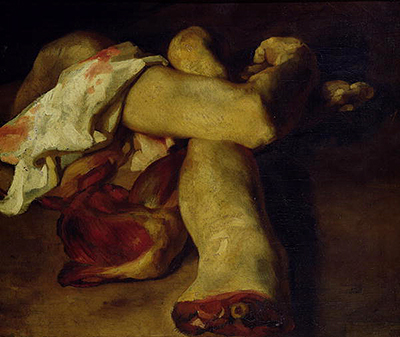In much the same way that an artist today would take a huge number of photographs of their subjects before setting to work with a large commission, so too did artists of old practise elements of a big commission or work that they were planning.
These studies could be sketches – sometimes in pencil in the margin of a book, sometimes a full-sized oil painting in its own right. It is the latter that Theodore Gericault used as a run up to his immense work the Raft of the Medusa. The painting was based on a 1816 tragedy in which poor lifeboat supplies and the thoughtlessness of the captain of la Meduse saw over 135 survivors of a ship running aground becoming lost at sea for twelve days as they drifted on a massive makeshift raft, dying in torments of thirst and starvation and becoming unwilling cannibals as they tried their best to survive the traumatic experience.
France was horrified by the incident, and Gericault was too, spending long hours speaking to the survivors who would talk to him, and visiting morgues, hospitals and prisons to gather various body parts from executed criminals, amputees and deceased persons. He took these grisly prizes to his studios where he allowed them to decompose, watching and sketching the results as time and bacteria wreaked their havoc on the pieces – a very early kind of 'body farm' style investigation.
Gericault's aim, throughout the whole process, was to paint a memorial to the survivors of the Medusa and in this he succeeded – the finished work measures an immense 5 metres by 7 metres approximately – but along the way, he captured a number of studies and images that caught his attention enough that he produced them as full (if small) oil paintings in their own right. It is one of those, Anatomical Pieces that is displayed here.
A heap of limbs are arranged, if such a word can be used for so casual a display, in the centre of the canvas, seeming very like joints of meat except for the pathos of what is clearly a human arm on top of the heap, curved casually around another limb, much as a young person sits with their knees up and their arms wrapped around their knees. The merest suggestion of a disembodied foot extending out of the pile speaks to the indignity that has occurred, the dismantling of what used to be a person.
Gericault was frail and ill for much of his life, and he was aware that mental ill-health too, ran through his family. It is perhaps this awareness of his own mortality that enabled him to treat what would normally be gruesome and unpleasant with a kind of bitter pity. The painting has not travelled far over the years and is to be found in Gericault's home town of Rouen, in the Musee de Beaux Art there. Oil on canvas this small grim study measures a mere 37 centimetres by 46 centimetres.




